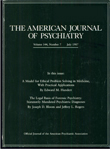Anorexia Nervosa in One Monozygotic Twin
TO THE EDITOR: Anorexia nervosa is a multifactorial disorder of unknown etiology, but genetic factors may play a significant role. A review of several twin studies on anorexia nervosa (1) concluded that there was a higher concordance rate in monozygotic twins (56%) than in dizygotic twins (7%), and the vulnerability component of anorexia nervosa attributed to genetic influences was estimated as around 76% (2). Molecular genetics has not yet located the genes potentially involved, partly because the inherited phenotype is unknown (3).
We report the case of a female patient with anorexia nervosa whose monozygotic monochorionic twin, having passed through the age at risk, has not developed anorexia nervosa. The coping strategy and the specific eating behaviors of the unaffected twin sister may highlight what is inherited in anorexia nervosa.
Both subjects were evaluated with the Diagnostic Interview for Genetic Studies, and the zygosity and chorionism are relatively certain, since they were technically confirmed by the mother, who is a general practitioner.
Ms. A, the proband, was 45 years old when she was examined for delirium after surgery. She is married, has two children, and works as a specialized practitioner. She developed anorexia nervosa at the age of 15 years, after going on a diet, without initial overweight. Her weight fell from 45 to 33 kg (height=1.60 m; body mass index=12.9). She had amenorrhea for more than 5 years and regularly used laxatives and engaged in self-induced vomiting.
In an interview with the twin sister, a married woman with two children, a simple phobia was the only disorder detected. Nevertheless, the sister is greatly concerned about her body image and cannot stand eating any food associated with milk. She has frequent periods of dieting when she eats only vegetable soups for days. Her weight fluctuates precisely between 47 and 50 kg (height=1.60 m; body mass index=18.4–19.5). She explained that she was shocked that her sister developed anorexia nervosa and therefore decided to watch her weight in order to avoid having it fall below 47 kg, the weight at which her twin sister began to lose control of her eating behavior.
We think that intentional and constant avoidance of weight loss below a critical threshold protected the unaffected twin sister from developing anorexia nervosa, even though she inherited vulnerability factors. Research on anorexia nervosa should therefore focus on more general body concerns rather than eating disorders with clinical complications, such as amenorrhea.
1 Labuda ML, Gottesman II, Pauls DL: Usefulness of twin studies for exploring the etiology of childhood and adolescent psychiatric disorders. Am J Med Genet Suppl 1993; 48:47–59Crossref, Google Scholar
2 McGuffin P, Katz R: Nature, nurture and affective disorder, in The Biology of Depression. Edited by Deakin JFW. London, Gaskell Press, 1986Google Scholar
3 Bruins Slot L, Gorwood P, Bouvard M, Blot P, Adés J, Feingold J, Schwartz JC, Mouren-Siméoni MC: Lack of association between anorexia nervosa and the D3 dopamine receptor. Biol Psychiatry (in press)Google Scholar



